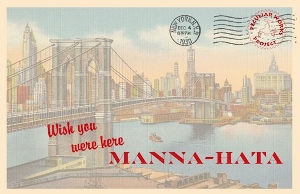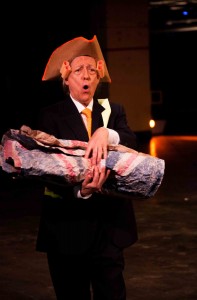GOING POSTAL OVER NEW YORK
Soaked to the skin and wrestling with a flimsy umbrella, I splashed across Eighth Avenue while reading the inscription on the James A. Farley Post Office, “Neither snow nor rain nor heat nor gloom of night stays these couriers from the swift 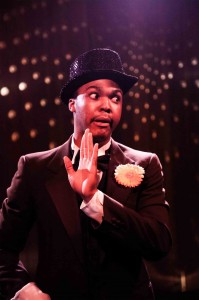 completion of their appointed rounds.”
completion of their appointed rounds.”
Well, here was I, as intrepid as those couriers, off to the post office not to deliver a package, but to write a review of Manna-Hata, a promenade theater piece about the history of New York City by the Obie Award-winning company Peculiar Works Project.
My friends and I joined the crowd milling around in the southern end of the imposing lobby. “Hmm, let’s see,” the woman at the makeshift box office said, “I’ll give you Jane.” I was excited to learn that she meant Jane Jacobs, one of my heroes. Other groups were led by the poet Walt Whitman, 1972 Democratic presidential hopeful Shirley Chisholm, and Easanques, the Lenape Chief who brokered with the Dutch in 1629.
“Who’s Jane Jacobs?” a 50-ish woman in our group asked as we were joined by Catherine Porter, playing Jane Jacobs in a red suit and those trademark cat-shaped eyeglasses. Breaking out of character for a moment, Porter gave a cursory explanation: activist and writer of The Death and Life of Great American Cities. I 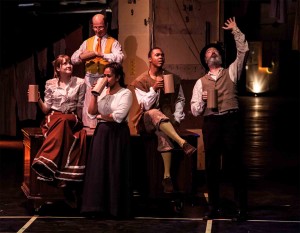 wanted to add that she led a movement that prevented Robert Moses, one of the most powerful men in America, from building a highway through downtown Manhattan.
wanted to add that she led a movement that prevented Robert Moses, one of the most powerful men in America, from building a highway through downtown Manhattan.
But we were already on our way up the graceful banisters to a long hallway, where we were instructed to plaster ourselves along the wall. For the next three hours, the cast shepherded us through various rooms on the upper level of the post office, which isn’t as glamorous as one might assume from the imposing gilt and marble lobby. Suffering from a bad makeover in the 1960s or 70s, and soon to be gutted and turned into the Moynihan train station, the setting proved to be less than ideal, especially with little adornment and few seats.
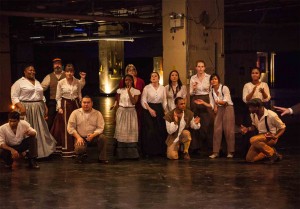 Barry Rowell, who wrote the play and co-directed it with Katherine Amshoff, starts off by pitting monied interests against community interests. But this interesting perspective of New York City’s history gets a little lost in the general discursiveness of the production. I wished we heard more directly from the sources that inspired the play. Besides Chisholm’s stirring acceptance speech, a few paragraphs from Jacobs’ The Death and Life of Great American Cities and snatches of poems by Whitman, Edna St. Vincent Millay and Miguel Piñero, much of the writing seemed to be culled from rambling improvisations. If brevity is the soul of wit, the bohemians in Pfaff’s cellar and at the Algonquin Roundtable were peculiarly lacking in soul.
Barry Rowell, who wrote the play and co-directed it with Katherine Amshoff, starts off by pitting monied interests against community interests. But this interesting perspective of New York City’s history gets a little lost in the general discursiveness of the production. I wished we heard more directly from the sources that inspired the play. Besides Chisholm’s stirring acceptance speech, a few paragraphs from Jacobs’ The Death and Life of Great American Cities and snatches of poems by Whitman, Edna St. Vincent Millay and Miguel Piñero, much of the writing seemed to be culled from rambling improvisations. If brevity is the soul of wit, the bohemians in Pfaff’s cellar and at the Algonquin Roundtable were peculiarly lacking in soul.
The amorphousness of the play was not helped by the design. Beyond the agreeable costumes by Angela Harner, there were few references to time or place in the language of Roswell’s script, the original music by Howard Fishman, or in the visual design by Lake Simons. It was a little disappointing to enter various badly carpeted 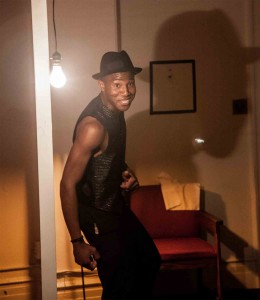 offices with drop-ceilings that purported to be the Cotton Club, the Algonquin Hotel, and the Cedar Tavern.
offices with drop-ceilings that purported to be the Cotton Club, the Algonquin Hotel, and the Cedar Tavern.
And maybe I’m just a curmudgeonly NuyorAsian, but the play really didn’t do justice to the outrage and in-your-face directness that New Yorkers are so infamous for. The use of repetitive rhythmic movement choreographed by Lynn Neuman was too orderly to convey the chaos, violence and spontaneity of the 1863 New York draft riots, the Triangle Shirtwaist Fire and the 1969 Stonewall riots. Bradley Wells was just too good-looking and nice to play Moses, the ruthless “master builder” of New York, and Peter Stuyvesant, the dour peg-legged governor of New Amsterdam. Rather than a rancorous wrestling match between Jacobs and Moses with the life of the city hanging in balance, we got a lot of hallway pacing and desk pounding.
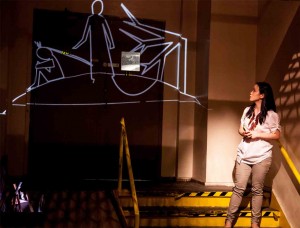 That’s not to say there weren’t some ingenious moments. A line drawing of the myth of the Lenape came to life through the miracle of a timely video projection by Myrel Chernick. The grid of the city was laid out by the 21-member ensemble with a few rolls of tape. In the wake of the draft riots, clothing hung on a line was taken down tenderly like bodies of those lynched. Cherrye J. Davis gave a rousing acceptance speech as Chisholm that had everyone cheering. And in the most satisfying moment of the play, the audience was invited to stroll a Brooklyn Bridge created from ribbons and an immense string of lights. Nodding to one another as we all crossed the bridge – strangers, lovers, and friends alike – there was a brief moment where Manna-Hata managed to truly capture the essence of what makes New York City so wonderful.
That’s not to say there weren’t some ingenious moments. A line drawing of the myth of the Lenape came to life through the miracle of a timely video projection by Myrel Chernick. The grid of the city was laid out by the 21-member ensemble with a few rolls of tape. In the wake of the draft riots, clothing hung on a line was taken down tenderly like bodies of those lynched. Cherrye J. Davis gave a rousing acceptance speech as Chisholm that had everyone cheering. And in the most satisfying moment of the play, the audience was invited to stroll a Brooklyn Bridge created from ribbons and an immense string of lights. Nodding to one another as we all crossed the bridge – strangers, lovers, and friends alike – there was a brief moment where Manna-Hata managed to truly capture the essence of what makes New York City so wonderful.
Manna-Hata
Peculiar Works Project
James A. Farley Post Office, 425 Eighth Avenue
(enter on West 31st Street, just west of 8th Avenue)
scheduled to end on Sunday June 23, 2013
for tickets, call 866-811-4111
or visit http://www.peculiarworks.org
